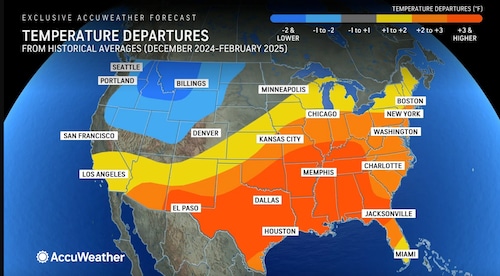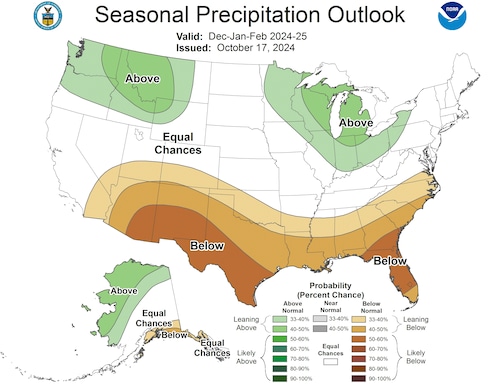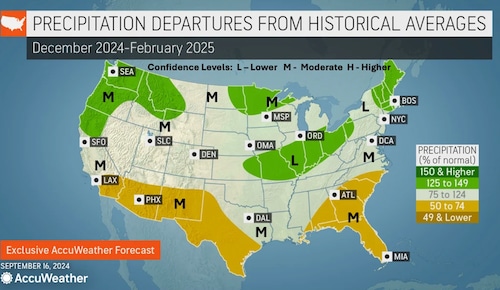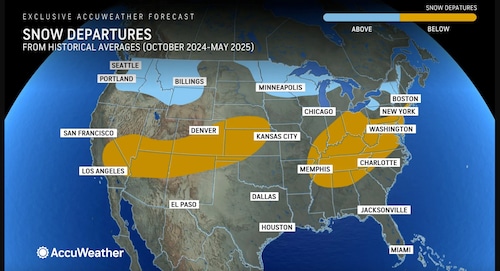Winter forecasts are fun to look at. Let’s compare two detailed winter forecasts from NOAA and AccuWeather.
There are often several factors that can point us in the right direction of what winter may be like in general terms.
Both winter forecasts are based on a La Niña occurring this winter. Just because both forecasts have one similar key factor, it doesn’t mean the forecasts are exactly alike.
The forecasts are very similar, which gives higher confidence that two very experienced weather organizations foresee somewhat similar winter conditions. AccuWeather‘s winter forecast is slightly warmer than NOAA’s forecast for Michigan and the Great Lakes region. NOAA’s forecast is somewhat wetter than AccuWeather.
Here are the two temperature forecasts.

Temperature forecast for December to February from NOAANOAA
The AccuWeather temperature forecast below has a much larger area of warmer-than-normal conditions. In general terms, however, both forecasts think winter will be mild in the East and the South up to Michigan. AccuWeather’s forecast gives us the magnitude of warmer-than-normal temperatures, pegged at one to two degrees warmer than normal.

AccuWeather winter forecast shows a large part of the U.S. is expected to be warmer than normal this winter.Accuweather
A winter that‘s one to two degrees warmer than normal will still be cold in Michigan. To put it in perspective, last winter’s second warmest winter on record was around seven degrees warmer than normal.
Both forecasts have based this shape on a storm track created by La Niña. Tom Kines, Senior Meteorologist at AccuWeather says they feel a weak La Niña will shift the storm track northward along the Pacific Northwest Coast. He says a strong La Niña typically has a strong storm track into California. With the storm track farther north into Washington, the storm systems will wind up farther north, possibly tracking over the Great Lakes. When a winter storm center tracks over Michigan we get a day or two of mild air before the storm. The AccuWeather forecasters feel this weather scenario will bring bouts of mild air into Michigan occasionally this winter.
Paul Pastelok was actually the AccuWeather meteorologist that produced their winter forecast. Pastelok tells me the current global warming is incorporated into the winter forecast. Pastelok says, “We are more cautious about when to predict colder than average areas in the nation.”
It doesn‘t look like a dry winter if either NOAA’s forecast or AccuWeather‘s forecast verifies. NOAA has much higher confidence in above normal precipitation, but AccuWeather’s precipitation forecast also shows ample moisture.

December to February precipitation forecast from NOAANOAA
Both precipitation forecasts show wet weather as storms enter the Pacific Northwest. NOAA brings the heavier precipitation back in the Great Lakes after those storms track across the northern Plains. AccuWeather seems to think Lower Michigan may have around normal amounts of precipitation, but be situated between two wet areas.

December to February precipitation forecast from AccuWeather.NOAA
One nice thing AccuWeather‘s winter forecast gives us that NOAA doesn’t is a snowfall forecast. Here AccuWeather thinks lake-effect snow cold be heavy. They paint the northwest part of Lower Michigan and the Upper Peninsula with more than average snowfall.

Snowfall forecast for winter 2024-25 from AccuWeatherAccuweather
If we put the two forecasts together we get a slightly warmer than normal winter. With these two forecasts it won’t be warm enough to call it a warm winter.
It also looks like storm systems will be numerous. We will need the waterproof boots, the snow shovel and even the ice scraper many times this winter if we do indeed get into the storm track from the Pacific Northwest.
AccuWeather’s Paul Pastelok also believes winter could come early to Michigan and end with a fury. He thinks we could have a lull in the middle of winter with not a whole lot going on mid-winter.
Regardless of the forecast, it‘s Michigan. We will have winter. We will shiver and shovel. It’s just a question of how much shivering and shoveling.
